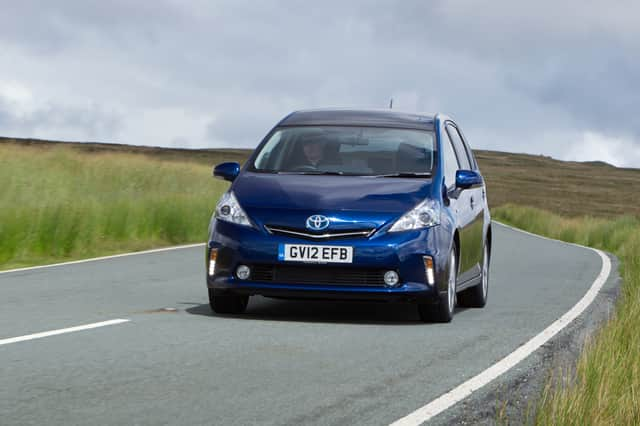Let us Prius!


Along with all the hot air that has to be spouted in order to keep a little ’un in line as he or she gains the abilities required to create yet more mischief, it has to be said that families just aren’t good for the environment.
Toyota have stepped in to try and absorb some of this impact.
Advertisement
Hide AdAdvertisement
Hide AdDays out with the kids can now be carried out safe in the knowledge that a vehicle is now available that is capable of emitting zero CO2 under certain conditions, and a claimed 96g/km on average, while comfortably transporting a glacier melting, ozone-dissolving family of seven.
Slotting the Prius’s 1.8-litre petrol engine and 56 cell Lithium-Ion battery-powered motor into a vehicle some 135mm longer, 30mm wider and 85mm taller — not to mention 145kg heavier — could have posed some performance drawbacks.
But with 98bhp and 105lb.ft. of torque and a Lithium-Ion battery powered motor emitting 81bhp and 153lb.ft. a 1.4 second addition to the Prius hatchback’s claimed 10.4-second sprint to 62mph time is unlikely to trouble most potential buyers.
Those after a Prius desire green motoring and the 64.2mpg fuel economy claims and 101g/km CO2 emissions of the T-Spirit spec Prius+ driven here are pretty appealing.
Advertisement
Hide AdAdvertisement
Hide AdThe plusher of two available specifications, the T-Spirit tables a 4.7mpg shortfall and 5g/km greater CO2 emissions score compared to the entry-level T4-spec (the hatchback claims 72.4mpg and 89g/km).
At £29,795, it also commands a £3,400 price premium.
Toyota’s assertion that the Prius+ is the world’s first seven-seat pure hybrid ensures that there are few direct rivals, so it is left to the T-Spirit to be the sector’s most premium offering.
With leather upholstery, a panoramic sunroof, climate control, cruise control, keyless entry and push button start, a rear-view reversing camera and a 6.1-inch touchscreen sat/nav system, the specification stands up to scrutiny very well.
While 17-inch alloys and tinted glass add to the premium appearance from the outside, the interior’s packaging is as flexible as any modern MPV, with no sign that all that hybrid drivetrain has prompted any compromises.
Advertisement
Hide AdAdvertisement
Hide AdThe second row of seats incorporates three individual chairs which slide fore and aft through up to 180mm, prioritising leg room or load space, or can be folded flat.
Each row of seats is 45mm higher than the one in front — allowing a decent forward view for passengers — and 25mm has been sliced out of the front seats to liberate extra legroom.
Boot space is 232 litres with all seven seats in place, 784-litres with five in place or 1,750 with all but the front seats folded flat.
Access to two rearmost seats is easier than in many established seven-seat MPVs and, once in, they offer reasonable comfort for even adult-sized occupants.
Advertisement
Hide AdAdvertisement
Hide AdGiven the relatively compact exterior appearance, the Prius+ represents a Tardis-like achievement for Toyota’s designers.
Driving a Prius is always a novelty for someone used to more conventional modes of transport.
From the natty, spring-loaded blue gear selector to the display that communicates where power is coming from at any given time (i.e. engine or motor) it all feels futuristic and quirky, without being outright alienating.
There are swathes of hard plastic but no rattles.
EV, Eco and Power modes can be accessed via buttons on the centre console.
Advertisement
Hide AdAdvertisement
Hide AdThe former powers the Prius purely on electric until the batteries’ charge runs out, Eco mode numbs throttle response and adjusts air conditioning to cut fuel consumption and Power sharpens throttle response by 25 per cent.
In reality, anyone selecting the Power option is defeating the object of their purchase in my eyes, but it does demonstrate that the Prius can summon a useful turn of pace, largely thanks to its electrically-charged torque.
The Prius+ will accelerate to 31mph on electric power before the engine cuts in, the transition is smooth and the only real drawback of such silent progress is stray shoppers who don’t hear the Toyota approach in a supermarket car park.
Toyota claims better fuel consumption from its hybrid drivetrain in an urban driving environment and so it proved during my test.
Advertisement
Hide AdAdvertisement
Hide AdOn a long run involving a quick motorway cruise I averaged an indicated 50mpg, with 60mpg on local journeys.
Encouraging me to drive sedately throughout my test was the Prius+’s CVT transmission. Fitted as standard, it guarantees that a drone of inharmonious engine revs accompanies every effort at sustained acceleration.
Feel through the brakes, which generate electricity to charge the battery under use, is very limited, meanwhile, meaning it’s easy to barrel into corners carrying more speed than anticipated.
Better to drive the Prius as it demands, calmly, keeping the kids in the back satisfied by telling them that you’re not “nearly there yet” and chasing those mpg scores.
There’s no doubting that it’s one of few MPVs that can safely claim to emit less than the family it transports...